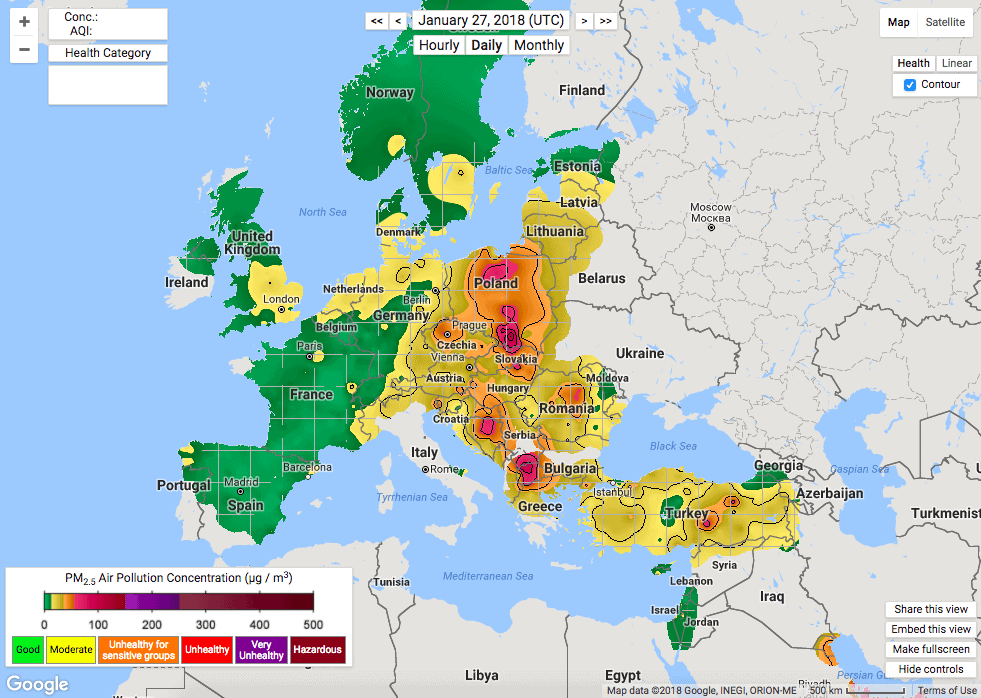Air quality data is concluding that those living in Eastern Europe and the Balkans are breathing in dirtier, more polluted air. This is largely due to using more coal and wood stoves.
Europe is divided by the air we breath in the East and the West. When we talk about the future of Europe we cannot ignore the air quality divide. pic.twitter.com/oYzPKlFbTb
— Julian Popov (@julianpopov) January 28, 2018
A recent tweet by Julian Popov, a fellow at the European Climate Foundation and the former environment minister of Bulgaria, highlighted the divide between the central and western parts of Europe, and the rest of the continent (countries like Italy and Romania have no data because they haven’t linked their monitors to the European Environmental Agency).
In case you’re wondering, Popov’s data isn’t skewed. He presented data from the European Air Quality Index, but other sources back it up. For instance, the real-time air-quality map maintained from Berkeley Earth paints a similar picture.

If the above image seems oddly familiar, it’s because it closely resembles the Iron Curtain — the name for the boundary set by the USSR after World War II to isolate itself and other countries under its influence from any Western influence. The Iron Curtain lasted from 1945 to the end of the Cold War in 1991, but its inglorious influence is still greatly felt, both in economic and social terms. In a larger number of indicators, countries who were under Russian influence simply have it worse off — they have a lower life expectancy, they’re less happy, they’re less healthy, they have weaker democracies, and so on. Well, now you can add “they have worse air” to that long list.
This isn’t exactly news, but it paints a grim picture, and a lot of it has to do with coal. Poland, for instance, is a country with vast reserves of coal, where coal is still the cheapest form of energy. As a result, it burns a lot of it, and the results are visible. According to the World Health Organization (WHO), 33 of the 50 most-polluted cities in Europe are in Poland, and the country is often plagued by smog — yet its government still says that burning coal is “patriotic”.
The second “dirtiest” European country after Poland is Bulgaria. In Sofia, Bulgaria’s capital, particulate matters in the air often reach unsafe levels, and the city’s efforts to purchase eco buses have so far proved insufficient in making any observable difference.
The Balkans also show extremely little interest in shifting towards cleaner sources of energy. Like almost all areas beneath the Iron Curtain, countries have exhibited a quick Soviet-style industrialization, with scant attention paid to the environment. Now, people are paying the price, and it’s a hefty one.
According to the WHO, the combined effects of ambient (outdoor) and household air pollution causes about 6.5 million premature deaths every year, with low and middle-income countries suffering the most exposure.
Air pollution is a major concern everywhere in the world, as it can have a serious impact on both human health and the environment. However, there is a vast disparity in terms of air quality between developed and developing countries. The main reason for this disparity is “solid fuel heating” (meaning more wood and coal stoves), which is consistent with the wealth disparity between Eastern and Western Europe. Western Europe has been able to afford to slowly move away from coal and has put much more emphasis on environmental development, even at times when this approach was more costly.
For now, things are as they have been, and winter is especially dangerous. Winters can be extremely harsh, and people will use more heating — which means they’ll burn more coal and wood. Winter air pollution is also worsened by another aspect: temperature inversion. Typically, the polluted air is warmer and therefore rises up and dissipates quicker, but in the wintertime, it is trapped near the ground by the colder, air which acts as a blanket.
The winter comes and goes, but at least for now, coal seems set to stay.



